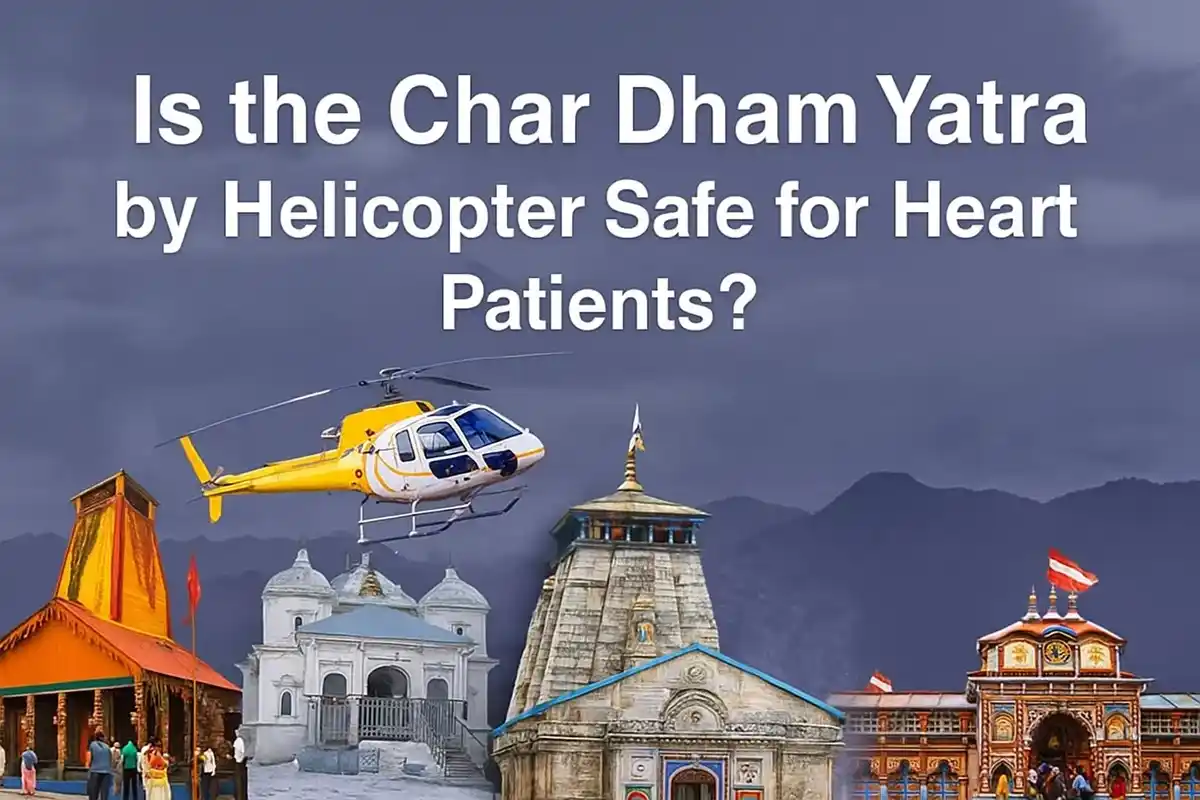Last Updated on 17/06/2025
People suffering from heart trouble might find it more challenging to take a high-altitude journey. Even though helicopter journeys are not physically taxing and can save time, flying at extreme heights, cold conditions, and less air can negatively affect one’s heart. The doctors focus on assisting heart patients with these activities, depending on how their bodies will withstand the pressure, especially when they are not habitual to taking long trips or get exhausted from driving.
This writing reviews whether using helicopters for high-altitude pilgrimages is scientifically safe for heart patients or not, along with mentioning the key precautions. By learning about their health, altitude changes, and planning special care for their trip, a traveler can plan a safe and comfortable spiritual holiday in Uttarakhand.

Physical Challenges of the traditional Char Dham Yatra
Usually, this divine yatra in Uttarakhand means traveling along small, winding roads, dealing with unpredictable weather, and taking lengthy journeys, mainly to Kedarnath. Going on such a journey can be dangerous for heart patients because they are at a greater risk of:
- Heavy exertion in high-altitude areas
- Hectic road journeys
- Fluctuating temperatures
- Limited availability of medical infrastructure
All the above listed factors can lead to breathlessness, fatigue, and even cardiac arrest in sensitive individuals.
How to Prepare for Char Dham by Helicopter as a Heart Patient?
- Select only reputable helicopter operators who have DGCA approval and guarantee safety with their helicopters and experts.
- Choose a friendly travel plan and avoid the rush with a 5N/6D tour instead of a single-day trip. It allows your body to relax between each darshan.
- Remember to keep yourself hydrated and eat foods that are easy to digest so as not to overload your heart. Choose light meals, stay away from spicy food, and drink more water.
- Always have your medical records and emergency numbers handy and explain them to both your guide and fellow travelers.
- Don’t try to visit too many temples in one go. Make it a point to take breaks regularly and skip using the stairs if you do not need to.
How Do the Elevations of Char Dham Affect Heart Patients?
Char Dham temples are found at heights that vary from 3,000 to 3,600 meters above sea level. Since the oxygen in the air is less here, it may become a problem for heart patients. If you plan the journey with your specialist, gradually get used to traveling, and create a good plan, you can take part in the pilgrimage safely.
- Kedarnath lies at a height of 3,583 meters.
- Badrinath stands at an altitude of 3,133 meters.
- The elevation of Gangotri is 3,048 meters.
- Yamunotri is nestled at an altitude of 3235 meters.
Benefits of Helicopter Travel for Heart Patients
- Less Travel Time- Aerial journey helps in reducing travel time, fatigue, and stress.
- Minimal Physical Exertion- As one doesn’t need to cover the strenuous treks, which makes it easier to reach the sites.
- Quick Access to Temples- Many helicopter packages are inclusive of VIP Darshan passes, cutting down waiting time at the shrines.
- Better Emergency Access- Reputable operators of helicopters usually offer first aid kits, oxygen cylinders, and are connected with emergency teams or medical units, mainly at helipads like Phata, Guptkashi, or Dehradun.
Precautions for Heart Patients Before the Yatra
Heart patients should take note of the following guidelines before starting the Yatra.
Medical Clearance
Performing a full cardiac check-up is required for all heart patients before starting the Yatra. See a cardiologist and get a document saying you meet the requirements for high-altitude travel and riding in a helicopter.
Medication Checklist
- Prescribed heart medications should be stored in the right amount.
- Have a record of the medications you can use in case of an angina or high blood pressure attack.
- Follow your doctor’s instructions and add aspirin or blood thinners to the treatment when needed.
Portable Oxygen
A few helicopter providers will allow passengers to take oxygen cans or concentrators on board. If you have experienced breathlessness or heart failure before, it’s a wise choice to try it.
Travel Insurance
Ensure that the travel insurance plan you choose can pay for emergency evacuation and covers any pre-existing heart diseases.


 Call
Call WhatsApp
WhatsApp Enquiry
Enquiry